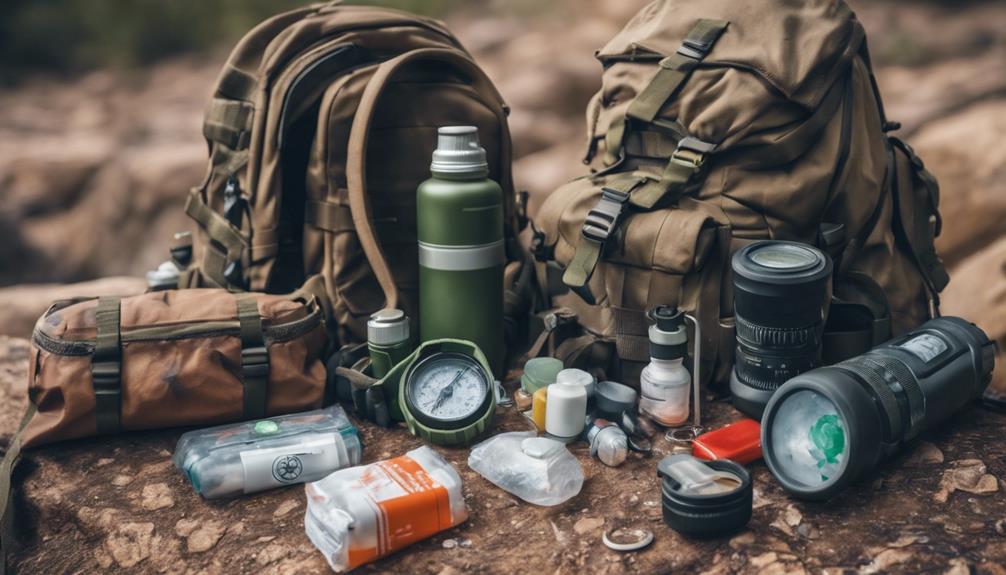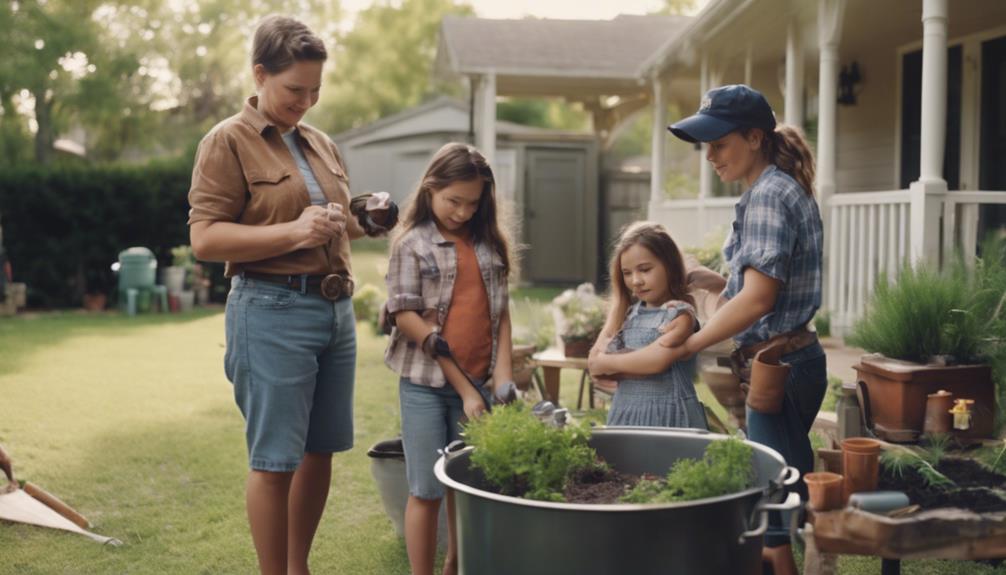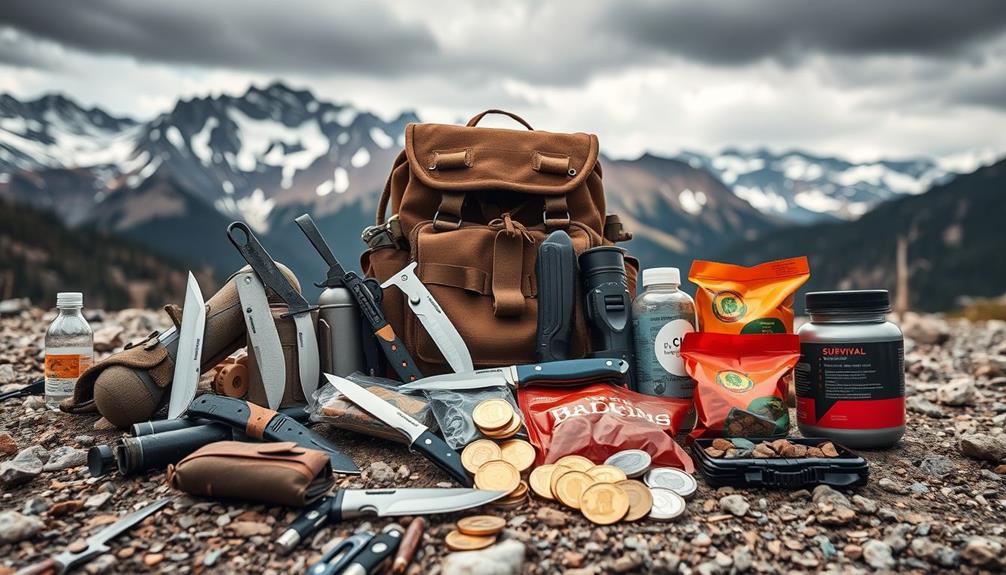To boost your everyday readiness, start with compact first aid kits, multi-tools, and flashlights for versatile use. Maintain fuel tanks at least half full for winter warmth and inspect regularly to prevent issues. Stay vigilant by observing surroundings and enhancing fitness with regular exercises and martial arts. Gradually build up emergency supplies like food, water, and communication plans for all scenarios. Stock non-perishable goods for power outages and organize important documents. These easy steps enhance your preparedness for any situation.
Key Takeaways
- Carry a compact first aid kit, multi-tool, and flashlight daily.
- Practice situational awareness by observing surroundings and recognizing threats.
- Maintain fitness with regular exercise and martial arts for readiness.
- Inspect fuel tanks regularly, keep them half full, and rotate stored fuel.
- Gradually build up emergency supplies, starting with a 3-day supply of food and water.
Everyday Carry Essentials
Wondering what everyday carry essentials you should have on hand for any situation that comes your way? When it comes to EDC gear, a well-rounded kit can make a significant difference in emergency situations.
One essential item to include in your EDC is a compact first aid kit. This kit should contain essentials like bandages, antiseptic wipes, pain relievers, and any personal medications you may need. In unexpected scenarios, having this kit readily available can help you address minor injuries or provide aid until professional help arrives.
In addition to a first aid kit, other EDC gear to ponder includes a multi-tool for various tasks, a flashlight for illumination in dark situations, and a pocket knife for everyday cutting needs. These tools can be invaluable in a pinch.
Fuel Tank Maintenance

Maintaining your fuel tank in good condition is essential for everyday readiness. Regular inspection and cleaning routines can help prevent issues and guarantee your vehicle is always prepared for unexpected situations.
Fuel Tank Inspection
Regularly check the fuel level in your tank to make sure it's adequately filled for both emergencies and everyday convenience. Keeping your fuel tank at least half full can prevent condensation and rust build-up, safeguarding the tank from damage. This practice ensures that you have heat during cold weather if stranded and enough fuel for unexpected situations.
Additionally, rotating the fuel in stored containers helps maintain freshness and readiness in case of emergencies. Maintaining appropriate fuel levels in your vehicle is essential for preparedness, allowing you to be ready for evacuation or travel when unforeseen circumstances arise.
Regular Cleaning Routine
To maintain the readiness of your fuel tank, implementing a regular cleaning routine is imperative for ensuring peak performance and longevity. Here are three essential tips for fuel tank maintenance to keep you prepared for everyday readiness and emergency situations:
- Keep your fuel tank at least half full: This practice can prevent fuel system issues, condensation buildup, and fuel pump failure, ensuring that you have a reliable fuel source when needed most.
- Regularly maintain your fuel tank: By staying on top of cleaning and upkeep, you can avoid running out of gas during unexpected situations or emergencies, providing a sense of security and readiness.
- Store fuel for emergencies: Having a full tank of gas can be critical during natural disasters, power outages, or evacuation scenarios, offering an essential resource for heat in winter emergencies and ensuring you can stay warm if stranded.
Embracing fuel tank maintenance as part of your routine contributes to overall preparedness and safety, making it a simple yet effective habit to adopt.
Situational Awareness Practices

To enhance your situational awareness, start by actively observing your surroundings for any potential threats or risks. Recognize the importance of noting exits, safe zones, and unusual behaviors that could indicate impending dangers.
Observing Surroundings for Safety
Practicing situational awareness involves actively observing your surroundings for potential threats or dangers. To enhance your safety through awareness, follow these tips:
- Stay Alert: Continuously scan your surroundings for any changes, like unfamiliar individuals, sudden noises, or unusual activities. These could indicate a significant threat that requires your attention.
- Regular Scanning: Make it a habit to regularly scan your environment, whether you're at home, work, or out in public. This consistent observation can help you identify any anomalies quickly.
- Trust Your Instincts: If something feels off or out of place, trust your instincts. Your intuition can often alert you to dangers that may not be immediately apparent.
Being aware of your surroundings and trusting your gut feelings can be vital in keeping yourself safe and prepared for unexpected situations.
Recognizing Potential Threats
Enhance your safety and preparedness by actively recognizing potential threats through constant environmental scanning. Situational awareness involves staying vigilant and alert to your surroundings, identifying escape routes, and noting safe areas in places you frequent.
Stay attuned to any changes, especially keeping an eye out for suspicious individuals or unusual activities that may pose a risk. To develop a keen sense of situational awareness, trust your instincts and intuition. If something feels off or uneasy, be ready to take action to guarantee your safety.
Regularly practicing and updating your situational awareness skills is vital to being prepared for unexpected situations that may arise.
Remember to remain observant and proactive in evaluating potential threats in various environments, such as work, home, or public spaces. By staying informed and alert, you can better protect yourself and those around you from harm.
Fitness for Preparedness

Strengthen your physical readiness for emergencies by engaging in activities like hiking, running, and martial arts to improve your overall fitness levels. Here are three ways physical fitness can enhance your preparedness:
- Boosted Strength and Stamina:
Regular exercise not only increases your physical strength but also improves your stamina, ensuring you can handle the demands of emergency situations effectively.
- Enhanced Mobility and Agility:
Engaging in exercises like martial arts can greatly improve your mobility and agility, essential for moving through challenging scenarios with ease.
- Improved Resilience and Coordination:
Setting a workout schedule can enhance your resilience and coordination, making you better equipped to face unexpected emergencies confidently.
Gradual Emergency Supplies Build-Up

Consider beginning your gradual emergency supplies build-up by starting with a basic 3-day supply of essential items like food and water.
As you establish your emergency essentials stockpile, remember to rotate out expired items regularly to maintain freshness and effectiveness.
It may be beneficial to invest in a water filter for your food storage, enabling you to purify water from various sources during a crisis.
In addition to non-perishables, include perishable items like condiments and spices to diversify your meal options.
Plan for different time frames of emergency readiness, such as 72 hours, 2 weeks, and 3 months, to adequately cover a range of scenarios.
By gradually building up your stockpile, you can guarantee that you're prepared for unforeseen events without feeling overwhelmed.
Taking small steps over time won't only enhance your level of readiness but also provide peace of mind knowing you have the necessary supplies at hand.
Communication Plan Preparation

Start preparing your communication plan by designating emergency contacts and meeting points in case of separation during an emergency. Enhance your readiness by implementing the following tips:
- Designate Emergency Contacts: Choose reliable individuals who live outside your area to serve as emergency contacts. Make sure everyone in your group has their contact information.
- Include Alternative Communication Methods: Equip your emergency kit with items like walkie-talkies, signal mirrors, or whistles to communicate when traditional methods fail. Familiarize yourself with these devices beforehand.
- Practice Communication: Regularly practice using your communication devices with your family or group to ensure everyone can operate them effectively. Consider establishing a communication schedule for check-ins during extended emergencies.
Remember to store important contact information in a waterproof container in your emergency kit. Having a well-thought-out communication plan can greatly enhance your preparedness during emergencies.
Water and Food Storage Basics

Secure your emergency preparedness by establishing a solid foundation with proper water and food storage basics. When planning your supplies, start with a 3-day water supply and gradually build up to a two-week stockpile for unforeseen circumstances. It's important to rotate out expired food items regularly to maintain freshness and effectiveness in your pantry items. Include a variety of food items like condiments, spices, and non-perishables to guarantee both nutrition and flavor during emergencies. Investing in a water filter is a wise choice to purify water from different sources when clean water is scarce. For thorough readiness, plan your food and water storage for various time frames such as 72 hours, 2 weeks, and 3 months.
| Food Items | Pantry Items |
|---|---|
| Condiments | Spices |
| Non-perishables |
Consider these essentials to ensure you are well-prepared for any unexpected situation.
Power Outage Readiness Steps

When confronting a power outage, guarantee your preparedness by having essential items like flashlights, batteries, and portable chargers easily accessible for moving through darkened environments.
To guarantee you're ready for unexpected power outages in your everyday life, take these steps:
- Stock Up on Non-Perishable Foods: Have a supply of non-perishable foods, canned goods, and manual can openers on hand to sustain yourself during power outages.
- Consider Alternative Power Sources: Invest in a generator or alternative power sources to tackle prolonged outages and stay connected.
- Organize Important Documents: Keep identification, emergency contacts, and other critical documents in a waterproof container for easy access in case of power outages.
Frequently Asked Questions
What Is a Reasonable Amount of Prepping?
A reasonable amount of prepping involves having a basic supply of food, water, and essential supplies to sustain you and your family for at least two weeks. Acquire skills like first aid, fire-starting, and self-defense for effective emergency handling.
How to Be a Practical Prepper?
To be a practical prepper, start by learning basic skills like first aid, fire-starting, and navigation. Incorporate prepping into your daily routine. Focus on essentials like food, water, and medical supplies. Balance preparedness with your busy life to avoid overwhelm.
What Are Basic Prepper Supplies?
To be ready for emergencies, gather basic prepper supplies like food, water, first aid kit, flashlight, and batteries. Consider extras such as a multi-tool, emergency blanket, whistle, and hygiene items. Remember documents and communication devices.
What Is the Minimum Prepping?
In your journey towards readiness, envision the minimum prepping as your survival foundation. It includes a 72-hour kit, two-week food/water supply, communication plan, evacuation know-how, essential skills. Start small, grow strong.
How Do Everyday Readiness Tips Differ from Real-World Survival Tips in Prepping?
Everyday readiness tips focus on practical ways to be prepared for emergencies in your daily life, such as having a first aid kit and extra food on hand. On the other hand, realworld tips for survival encompass more advanced skills like finding water sources and building shelter in a wilderness setting.
Conclusion
To wrap up, remember to always stay prepared for any situation that may arise. By following these easy tips for everyday readiness, you can guarantee that you're equipped to handle emergencies with ease.
So, keep your essentials close, maintain your fuel tank, stay aware of your surroundings, stay fit, gradually build up your emergency supplies, prepare a communication plan, store water and food, and be ready for power outages.
Stay safe and be prepared!










